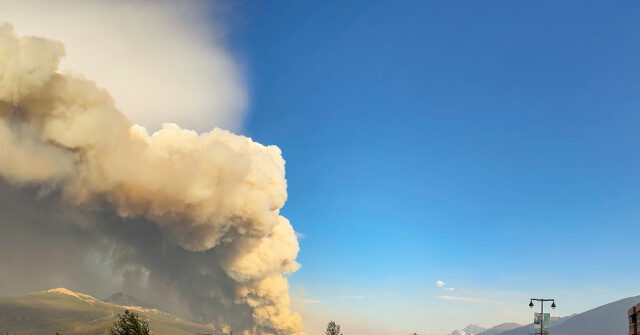The wildfire threatening Canada’s historic town of Jasper has quadrupled in size to more than 36,000 hectares and damaged up to half of the structures in town as of Friday.
No deaths have been reported, but at least 5,000 residents and 20,000 tourists in Alberta province have been displaced by the blazes.
“There is no denying that this is the worst nightmare for any community,” Alberta Premier Danielle Smith said tearfully at a press conference on Thursday as she described the damage to Jasper and its famed national park.
Jasper National Park is the largest park in the Canadian Rockies and the second-largest dark sky preserve (an area where there is almost zero light pollution, creating ideal conditions for astronomy and stargazing) in the world. Jasper is one of a half-dozen Canadian Rocky Mountain Parks to be declared UNESCO World Heritage Sites in 1984.
“With rugged mountain peaks, ice fields, and glaciers, alpine meadows, lakes, waterfalls, extensive karst cave systems, thermal springs and deeply incised canyons, the Canadian Rocky Mountain Parks possess exceptional natural beauty, attracting millions of visitors annually,” UNESCO noted in its designation.
Among the special features sought by visitors to Jasper National Park are its red Adirondack wooden chairs, placed by park management at the most beautiful and historic locations.
“We share the sense of loss with all of those who live in the town, who care for it, and who have helped build it. And to those in Alberta and around the world who have experienced the magic of Jasper: The magic is not lost, and it never will be,” Smith said on Thursday.
Parks Canada said it would be some time before the damage to Jasper and the national park could be fully assessed. Officials said the park “received a small amount of rain overnight” on Thursday, but it was not enough to make a “meaningful impact to the overall wildfire situation, which remains out of control.”
Photos and video posted to social media showed entire blocks of towns in Alberta reduced to smoldering rubble:
CBC News reported “blocks of buildings and houses turned to charred rubble and foundations,” lines of cars “blackened by fire” along the streets, and scorched trees standing like “matchsticks.” In a stroke of good fortune, the worst destruction seems to be concentrated in the southwestern half of Jasper, leaving its northeastern buildings largely undamaged.
Jasper National Park said in a Facebook post that “critical infrastructure” in the town, including its hospital, emergency services headquarters, schools, and wastewater treatment plant, had been mostly protected from the fire, but “a number” of its important bridges were damaged.
The wildfire reached the town of Jasper on Wednesday after gathering strength for days and blossoming into a firestorm because of high winds. On Thursday night, two previously distinct wildfires merged together, turning into a 36,000-hectare blaze.
Eyewitnesses described a three-hundred-foot wall of flame descending on the town, from which firefighters and rescue personnel were forced to retreat. Alberta Public Safety Minister Mike Ellis said the wall of flame was driven “five kilometers in probably less than 30 minutes” by wind gusts.
“What you’re dealing with is just a monster at that point,” Parks Canada fire management chief Pierre Martel said. “There are no tools we have in our toolbox to deal with that. At that point, you get out of the way, you retreat, and you do what you can to protect communities and infrastructure as best as we can.”
Alberta Wildfire officials said on Thursday that some firefighters who were forced to retreat due to poor air quality are ready to return to the front lines. Hundreds of firefighters from around the world are reportedly gathering in Jasper to protect as much of the town and national park as possible.
Thompson Rivers University wildfire specialist Mike Flannigan said the Jasper fire was so powerful that it created its own weather system of “pyrocumulonimbus” thunderstorms and high winds.
“The fuels were right and the conditions were extreme. It was such a high-intensity fire and the winds were pushing it up the valley, and fires love to run up and down valleys. It was just a tragedy to see it happen,” Flannigan said.
Some Canadians strongly objected to the inevitable “climate change” narrative for the wildfires, insisting the blame lies squarely on Prime Minister Justin Trudeau and his administration’s failure to implement sound fire management policies despite growing warnings:
The Jasper forest fires were NOT caused by climate change
They happened because we sent 12 billion dollars to Ukraine instead of equipping our own country with the equipment to fight fires
The Liberal Government FAILED to protect our National Park
Don’t let them gaslight you pic.twitter.com/WFVos3UMmV
— The Pleb Reporter (@truckdriverpleb) July 25, 2024
Toronto Sun political columnist Brian Lilley noted the opposition Conservative party has been warning about the growing danger from dead trees around Jasper for years:
Here’s just one example of the Conservatives asking about plans from the Liberal government to prevent a devastating forest fire in Jasper. The government knew about stands of dead trees killed by the Pine Beetle and didn’t act. This is from 2017. #jasper pic.twitter.com/ErzXs2Qv5o
— Brian Lilley (@brianlilley) July 25, 2024
Critics recalled Trudeau failing to deliver on campaign promises of dramatically increased funding for firefighters and said far too much energy was wasted on jurisdictional squabbles between federal, provincial, and park authorities.
Corporate and government adviser David Knight Legg on Friday blamed the “lax ‘leave it to nature’ green thinking in the Parks Canada bureaucracy,” which he described as a “notoriously slow, political, unresponsive maze that struggles to manage core functions.”
“Thousands of tweet/exchanges as recent as last month highlight local concern over Jasper as a tinderbox managed by a sclerotic bureaucracy at Parks for seven years,” he said.
“Why were there vast tracts of dead and desiccated tree-stands in Jasper that the locals have demanded action on since 2017? This was noted by academics, environmentalists and everyone working in and around Jasper for years. What was done?” he asked.
“Climate change didn’t leave acres of dead trees next to a beautiful mountain town for seven years. The government did,” he said, answering his own question.
National Post columnist Jamie Sarkonak made similar points on Thursday, accusing Parks Canada of creating “the perfect conditions for disaster.”
Sarkonak mentioned the trees killed by mountain pine beetles, creating abundant “fire fuel” that was not adequately cleared out with controlled burns. Parks Canada itself rated the clearance of dead growth as “poor” in 2022, a bland rating that understated just how bad conditions had become. She noted:
The area of the park’s montane forests – warm and dry valley ecosystems – was 86 percent below the historic norm as far as burned area goes. Higher up on the park’s mountainsides, the burned area was 88 per cent below the norm; the upper subalpine forests were only a little better, at 79 per cent under. Only Jasper’s old-growth forests, at 33 per cent below target, weren’t rated “poor.” It was a tinderbox, she noted.
Sarkonak quoted foresters who warned six years ago that Jasper National Park was a “powder keg waiting to blow up” unless the situation was defused with strategic logging and controlled burns. Parks Canada dismissed these warnings, saying it was “quite comfortable” with conditions in the park.
“The best time to prevent this fire was during summers past. With any hope, Ottawa will apply the dire lessons learned in Jasper to the rest of its mountain parks,” Sarkonak concluded.
RELATED — Wildfire Fleeing: Canadian Roads Packed as Alberta Residents Flee Wildfire
Faith De Ocampo Slater via Storyful







